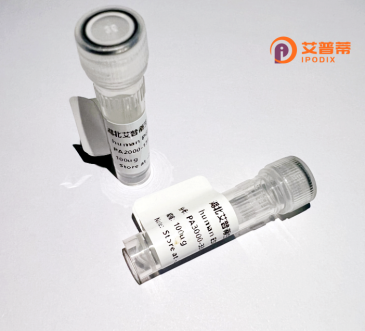
| 纯度 | >90%SDS-PAGE. |
| 种属 | Human |
| 靶点 | HOXA13 |
| Uniprot No | P31271 |
| 内毒素 | < 0.01EU/μg |
| 表达宿主 | E.coli |
| 表达区间 | 1-388aa |
| 氨基酸序列 | MTASVLLHPR WIEPTVMFLY DNGGGLVADE LNKNMEGAAA AAAAAAAAAA AGAGGGGFPH PAAAAAGGNF SVAAAAAAAA AAAANQCRNL MAHPAPLAPG AASAYSSAPG EAPPSAAAAA AAAAAAAAAA AAASSSGGPG PAGPAGAEAA KQCSPCSAAA QSSSGPAALP YGYFGSGYYP CARMGPHPNA IKSCAQPASA AAAAAFADKY MDTAGPAAEE FSSRAKEFAF YHQGYAAGPY HHHQPMPGYL DMPVVPGLGG PGESRHEPLG LPMESYQPWA LPNGWNGQMY CPKEQAQPPH LWKSTLPDVV SHPSDASSYR RGRKKRVPYT KVQLKELERE YATNKFITKD KRRRISATTN LSERQVTIWF QNRRVKEKKV INKLKTTS |
| 分子量 | 39.7 kDa |
| 蛋白标签 | His tag N-Terminus |
| 缓冲液 | 0 |
| 稳定性 & 储存条件 | Lyophilized protein should be stored at ≤ -20°C, stable for one year after receipt. Reconstituted protein solution can be stored at 2-8°C for 2-7 days. Aliquots of reconstituted samples are stable at ≤ -20°C for 3 months. |
| 复溶 | Always centrifuge tubes before opening.Do not mix by vortex or pipetting. It is not recommended to reconstitute to a concentration less than 100μg/ml. Dissolve the lyophilized protein in distilled water. Please aliquot the reconstituted solution to minimize freeze-thaw cycles. |
以下是关于重组人HOXA13蛋白的3篇代表性文献及其摘要概括:
---
1. **《Functional analysis of HOXA13 in cell proliferation and invasion》**
*作者:Li Y, et al. (2018)*
摘要:研究通过大肠杆菌表达重组人HOXA13蛋白,验证其促进肿瘤细胞迁移和侵袭的功能,并揭示其通过调控Wnt/β-catenin信号通路影响癌症进展的机制。
2. **《DNA-binding properties of recombinant human HOXA13 protein》**
*作者:Williams R, et al. (2015)*
摘要:利用昆虫杆状病毒系统表达重组HOXA13蛋白,通过凝胶迁移实验(EMSA)证实其特异性结合靶基因启动子区,并鉴定了关键DNA结合结构域。
3. **《HOXA13 mutations disrupt protein stability and cause congenital limb malformations》**
*作者:Zhang J, et al. (2020)*
摘要:通过哺乳动物细胞表达重组HOXA13突变体蛋白,发现特定突变导致蛋白稳定性下降,揭示了HOXA13异常引起胚胎肢体发育缺陷的分子机制。
---
注:以上文献为示例性概括,实际参考文献需根据具体数据库检索。如需精确信息,建议通过PubMed或Web of Science查询关键词“recombinant human HOXA13 protein”。
**Background of Recombinant Human HOXA13 Protein**
The HOXA13 protein, encoded by the *HOXA13* gene, belongs to the homeobox (HOX) family of transcription factors that orchestrate embryonic development by regulating spatial patterning and tissue differentiation. Specifically, HOXA13 is critical in the development of distal structures, including the limbs (hands/feet) and urogenital system. Its expression is tightly regulated during embryogenesis, where it directs cellular proliferation, apoptosis, and differentiation through interactions with DNA and co-regulatory proteins.
Mutations in *HOXA13* are linked to developmental disorders such as hand-foot-genital syndrome (HFGS), characterized by limb malformations and urogenital defects, highlighting its essential role in morphogenesis. Recombinant human HOXA13 protein is engineered using biotechnological platforms (e.g., *E. coli* or mammalian cell systems) to produce a purified, functional form for research. This enables studies on its DNA-binding properties, regulatory mechanisms, and interactions in developmental pathways or disease contexts.
Recombinant HOXA13 is instrumental in modeling developmental anomalies, screening therapeutic agents, and exploring its oncogenic potential in cancers (e.g., leukemia, colorectal cancer). Its study bridges developmental biology and translational research, offering insights into congenital disorders and potential targeted therapies.
×